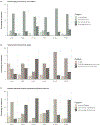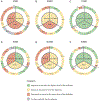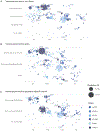Status and Trends of Physical Activity Surveillance, Policy, and Research in 164 Countries: Findings From the Global Observatory for Physical Activity-GoPA! 2015 and 2020 Surveys
- PMID: 36535269
- PMCID: PMC10115485
- DOI: 10.1123/jpah.2022-0464
Status and Trends of Physical Activity Surveillance, Policy, and Research in 164 Countries: Findings From the Global Observatory for Physical Activity-GoPA! 2015 and 2020 Surveys
Abstract
Background: Physical activity (PA) surveillance, policy, and research efforts need to be periodically appraised to gain insight into national and global capacities for PA promotion. The aim of this paper was to assess the status and trends in PA surveillance, policy, and research in 164 countries.
Methods: We used data from the Global Observatory for Physical Activity (GoPA!) 2015 and 2020 surveys. Comprehensive searches were performed for each country to determine the level of development of their PA surveillance, policy, and research, and the findings were verified by the GoPA! Country Contacts. Trends were analyzed based on the data available for both survey years.
Results: The global 5-year progress in all 3 indicators was modest, with most countries either improving or staying at the same level. PA surveillance, policy, and research improved or remained at a high level in 48.1%, 40.6%, and 42.1% of the countries, respectively. PA surveillance, policy, and research scores decreased or remained at a low level in 8.3%, 15.8%, and 28.6% of the countries, respectively. The highest capacity for PA promotion was found in Europe, the lowest in Africa and low- and lower-middle-income countries. Although a large percentage of the world's population benefit from at least some PA policy, surveillance, and research efforts in their countries, 49.6 million people are without PA surveillance, 629.4 million people are without PA policy, and 108.7 million live in countries without any PA research output. A total of 6.3 billion people or 88.2% of the world's population live in countries where PA promotion capacity should be significantly improved.
Conclusion: Despite PA is essential for health, there are large inequalities between countries and world regions in their capacity to promote PA. Coordinated efforts are needed to reduce the inequalities and improve the global capacity for PA promotion.
Keywords: epidemiology; guidelines and recommendations; health promotion; measurement; public health practice.
Figures







